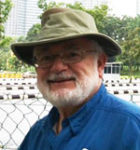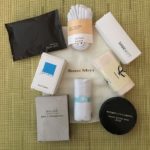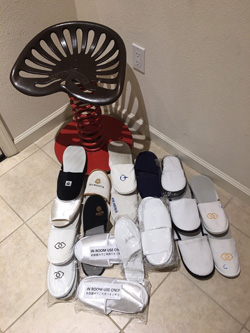(c) Oliver B. Pollak


RICHMOND, California — I wanted to do something nice for my wife. That’s the Jewish part of this story. She went to the doctor and to exercise. Her cordovan Dansko clogs were mighty scuffed. I would put life into them. A Caymus Winery wood box held rags, brushes, Kiwi black, brown, and cordovan polishes, edge dressing, saddle soap, Mink Oil leather softener, and a tooth brush for welts and stitching, An old buffing sock finished the job. Nearby a chipped coffee cup holds nine metal and plastic shoe horns, and one genuine shoe horn.
The Oxford English Dictionary records the use of ‘bootblacks’ in 1817, and ‘shoeshiners’ in 1910. They work at barbershops, train stations, airports, and better hotels; just leave the shoes outside the door, and in the morning, voilà, shined shoes.
Shoes are expensive, it makes sense to make them last. My mother shined shoes and reminded me to do the same. I spit shined my black leather Navy dress shoes but not as assiduously as my shipmates who applied lighter fluid. We had boondocker work shoes and low cut white canvass athletic shoes. The ‘enemy’ wore recycled tire treads.
The box also contained nine hotel amenities; shoe mitt, shoe cloth, boot buffer, shine sponge, PeterThomasRoth Shoe shine pad, and La Fresh travel-lite, “To make a polished impression, start with your shoes.” Too cute to leave behind, and apparently too cute to use at home. They were simply waiting for this story to arise.
Popular literature, movies and television suggest a girl can’t have too many shoes: Shoe Addicts Anonymous by Beth Harbison (2007); Kinky Boots (2005); and Sex in the City. Jimmy Choo, Manolo Blahnik, and Imelda Marcos became household words. Men are not immune to episodic shoe acquisition. Fashions, trends and attachments emerge, they peak and fade, like wines and car designs, waiting for the next best thing.
In the 20th century we kept baby shoes, sometimes even bronzed them, harkening back to learning to walk. Shoe stores thrive on biology; feet grow from three inches to over a foot. Feet change morning to evening, And the older we get, more so.
I wore little brown sandals and shorts in London. My earliest shoe store memory is seeing my bones. In the late 1940s and into the 1950s shoe stores used Fluoroscopes, Pedo scopes and Foot-o-Scopes, state of the art merchandizing, to show parents how the shoe fit. Radiation hazards led to regulation and abandonment.
My mother took me to Buster Brown in Los Angeles, at the Crenshaw shopping center. Brown, of St. Louis, Missouri, became Famous Footwear. In high school I had beige suede bucks, not Blue Suede Shoes popularized by Carl Perkins in 1955 and Elvis Presley in 1956. Thongs, zoris, flip flops, stay behinds, beach shoes, arrived in the 1960s.
Dark maroon high top Florsheim’s with a buckle were followed by black dress shoes. Cole Haan founded in 1928 by Chicagoans Trafton Cole and Eddie Haan, provided loafers, slippers, green canvas sneakers, and boots. I purchased Bally in Switzerland. A bunion terminated loafers which stay on because of (unwanted) pressure. I turned to Birkenstock cork and leather, and later Keens, and have worn out six pairs. Repurposed shoe boxes hold memories.
During our December 1999 millennial trip to Paris I lived in black Mephisto City Hikers. Since then I acquired brown, chestnut, and two tone dress and casual shoes from Nordstrom in Chicago, Kansas City, Minneapolis, and Honolulu, a vacation habit. Models were discontinued. Match eclipsed City Hiker. Mephisto in San Diego refurbishes via UPS.
Midwest winter, cold, snow and slush, calls for warm, waterproof with fur lining. High working shoes came from Famous Footwear; dark brown suede; BØrn thick soles from Von Maur, illusionary Scandinavian, stamped with a crown, are an American firm manufacturing in China, Mexico and Vietnam. Traveling into inclement weather: arrived in New York in the snow, Bloomingdales provided fur lined Kenneth Cole. Wyoming offered fur lined Cole Haan boots. Denver airport provided Johnston Murphy black zip up boots. We moved in 2016 to California’s more equable clime, the boots languish in the closet.

The name Sneakers dates from the 19th century. Merchants selling tennis, athletic, and gym shoes occupy many mall bays. Keds, Converse, Vans, Nike, Adidas, Air Jordan, sometimes allegedly made with child labor, are youthful fashion statements. I chose Salomons over Merrill’s to climb Mount Whitney. I razored the N. off New Balance. Worn shoes go to yard work then to the trash.
Having several pairs of shoes means they last longer. The shoe repair business is fading. According to Elana Centor in “The Changing Footprint of the Shoe Repair Industry” in Huffpost Business, July 24, 2007, it declined from 68,000 in 1968 to 7,000 in 2007.
We visited Toronto’s Bata Shoe Museum, Florence’s Salvatore Ferragamo Shoe Museum, and Barcelona’s Museu del Calçut. We accumulated many slippers and ask guests to leave their shoes at the entry and offer hotel, airline and cruise ship slippers.
In the morning slippers are at the ready, old Birkenstocks go through the garage to get the newspaper.
*
Pollak, a professor emeritus of history at the University of Nebraska at Omaha, is a freelance writer now based in Richmond, California. He may be contacted via oliver.pollak@sdjewishworld.com